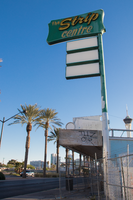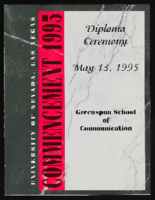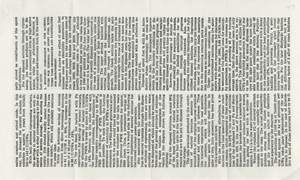Search the Special Collections and Archives Portal
Search Results
Southern Nevada Jewish Heritage Project
"The goal of this 2014-2015 project is to build a web and mobile resource that will connect researchers from around the world to thousands of historical items—photographs, brochures, scrapbooks, letters, drawings, videos, and more—detailing the lives and contributions of Jews in Southern Nevada. It will include carefully researched biographies, timelines, and histories of institutions, events, and prominent themes showing the integral roles Jews have played in the history of Southern Nevada.
Corporate Body
Walking Box Ranch Collection
Identifier
Abstract
The Walking Box Ranch Collection (1917-2011) includes material collected by the University of Nevada, Las Vegas (UNLV) Public Lands Institute on the Searchlight, Nevada ranch. Materials include a maps related to the construction and operation of the ranch, a pair of chaps owned by Rex Bell, Jr., and color slides of the ranch. Also included are photographic prints of Rex Bell and Rex Bell, Jr., and newsclippings related to the film and political career of Rex Bell. A small number of newsclippings pertain to the career of Rex Bell, Jr.
Archival Collection
Flora Dungan Papers
Identifier
Abstract
Flora Dungan Papers (1929-1974) contain high school and university records, certificates, newspaper clippings, press releases, notes, correspondence, and booklets about her life and political activism in Nevada. Also included are Legislative materials, an audio cassette tape, a copy of the Nevada Constitution, and an oil painting of Flora Dungan.
Archival Collection

Photographs of Strip Centre sign, Las Vegas (Nev.), March 24, 2017
Date
Archival Collection
Description
Sign owner: Has been for sale since 2013
Sign details: This location has is a little shopping mall, and is called the strip centre since they are near the north end of the strip. Though this location has been up for sale since 2013.
Sign condition: 3- has had some bad weathering over the years and the paint is quite faded now.
Sign form: Blade
Sign-specific description: This sign stand on top of the building above the entrance. It is a green base that reaches the top of the sign. On the top part there is a big green steel rectangle with yellow painted words "The Strip Centre" but the word "Strip" is contained in channeled neon while the other two words are skeletal neon. Beneath this is 3 green sign boxes that would contain back lit plastic signs, but there are no signs in them currently. To the south side of the main sign there are remains of a sign that look like it used incandescent light bulbs.
Sign - type of display: Neon and plastic back lit signs.
Sign - media: Steel and plastic
Sign - non-neon treatments: Plastic back lit portion
Sign environment: This location is on the north end of the strip. It is north of the Stratosphere by a few blocks but also has some motels and wedding chapels close to it.
Sign - date of installation: Has been up since at least 2009
Sign - thematic influences: The plastic back lit portion is helpful for malls like this since they can change out which stores are within the mall relatively easily without getting a whole new sign.
Survey - research locations: Google map roadside view, attempted assessor's page but could not find it
Survey - research notes: This location was hard to find information on since it is for sale. Also I could not find information on it the assessor's page for some reason.
Surveyor: Emily Fellmer
Survey - date completed: 2017-10-01
Sign keywords: Neon; Plastic; Backlit; Steel; Pole sign; Back to back
Mixed Content

University of Nevada, Las Vegas (UNLV) Greenspun School of Communication Diploma Ceremony program
Date
Archival Collection
Description
Commencement program from University of Nevada, Las Vegas Commencement Programs and Graduation Lists (UA-00115).
Text

Transcript of interview with Gil Cohen by Claytee White, August 5, 2014
Date
Archival Collection
Description
Interview with Gil Cohen by Claytee White on August 5, 2015. In this interview, Cohen discusses growing up in Las Vegas and attending University of Nevada at Reno. He returned to Las Vegas to join the management training program at the Stardust. He talks about his friendships with Moe Dalitz and Carl Cohen, and his interest in golfing. He also discusses corporate ownership of casinos, unions, and his experiences working at different Strip hotels.
Gil Cohen came to Las Vegas in 1957, when was ten years old, when his father, Yale Cohen, was recruited by Moe Dalitz to work at the Stardust Hotel and Casino. Cohen graduated from University of Nevada Reno, and started working at the Stardust through the management-training program. In 1975, he was made hotel manager, his first of many leadership positions in Strip properties, which have included the Dunes, Aladdin, Hacienda and Monte Carlo, where he currently works as a casino host.
Text

Francis Oh Allen-Palenske oral history interview: transcript
Date
Archival Collection
Description
Oral history interview with Francis Oh Allen-Palenske conducted by Stefani Evans on June 30, 2022 for Reflections: the Las Vegas Asian American and Pacific Islander Oral History Project. In this interview, Francis describes her childhood growing up in Lousiana with a white father and Korean mother. She recalls the family relocating to Reno, Nevada in 1983 where Francis obtained her bachelor's degree in political science from the University of Nevada, Reno in 1999. She describes serving as a staffer in Washington, D.C. for Representative Jim Gibbons (R-NV) before moving to Las Vegas, Nevada. She discusses her Korean mother, maternal grandmother, and maternal aunts as strong, smart, business-minded women. Throughout the interview, she discusses Korean traditions, celebrations, clothing, and foods, as well as Korean cosmetics and views about skin color.
Text
Ariana Saunders (The Corporation for Supportive Housing) oral history interview conducted by Kelliann Beavers and Elia Del Carmen Solano-Patricio: transcript
Date
Archival Collection
Description
From the Lincy Institute "Perspectives from the COVID-19 Pandemic" Oral History Project (MS-01178) -- Community organization interviews file.
Text

